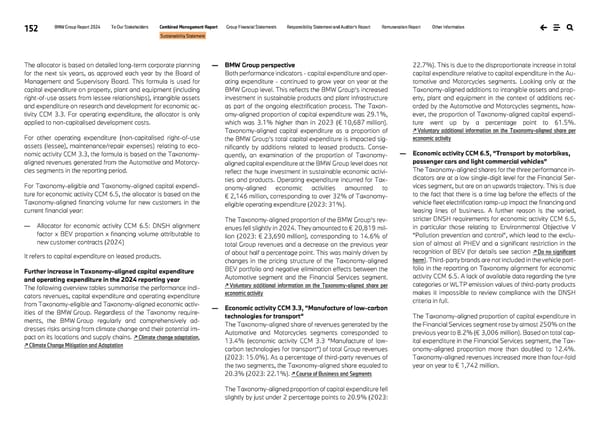152 BMW Group Report 2024 To Our Stakeholders Combined Management Report Group Financial Statements Responsibility Statement and Auditor’s Report Remuneration Report Other Information Sustainability Statement The allocator is based on detailed long-term corporate planning for the next six years, as approved each year by the Board of Management and Supervisory Board. This formula is used for capital expenditure on property, plant and equipment (including right-of-use assets from lessee relationships), intangible assets and expenditure on research and development for economic ac- tivity CCM 3.3. For operating expenditure, the allocator is only applied to non-capitalised development costs. For other operating expenditure (non-capitalised right-of-use assets (lessee), maintenance/repair expenses) relating to eco- nomic activity CCM 3.3, the formula is based on the Taxonomy- aligned revenues generated from the Automotive and Motorcy- cles segments in the reporting period. For Taxonomy-eligible and Taxonomy-aligned capital expendi- ture for economic activity CCM 6.5, the allocator is based on the Taxonomy-aligned financing volume for new customers in the current financial year: — Allocator for economic activity CCM 6.5: DNSH alignment factor x BEV proportion x financing volume attributable to new customer contracts (2024) It refers to capital expenditure on leased products. Further increase in Taxonomy-aligned capital expenditure and operating expenditure in the 2024 reporting year The following overview tables summarise the performance indi- cators revenues, capital expenditure and operating expenditure from Taxonomy-eligible and Taxonomy-aligned economic activ- ities of the BMW Group. Regardless of the Taxonomy require- ments, the BMW Group regularly and comprehensively ad- dresses risks arising from climate change and their potential im- pact on its locations and supply chains. ↗ Climate change adaptation, ↗ Climate Change Mitigation and Adaptation — BMW Group perspective Both performance indicators - capital expenditure and oper- ating expenditure - continued to grow year on year at the BMW Group level. This reflects the BMW Group’s increased investment in sustainable products and plant infrastructure as part of the ongoing electrification process. The Taxon- omy-aligned proportion of capital expenditure was 29.1%, which was 3.1% higher than in 2023 (€ 10,687 million). Taxonomy-aligned capital expenditure as a proportion of the BMW Group’s total capital expenditure is impacted sig- nificantly by additions related to leased products. Conse- quently, an examination of the proportion of Taxonomy- aligned capital expenditure at the BMW Group level does not reflect the huge investment in sustainable economic activi- ties and products. Operating expenditure incurred for Tax- onomy-aligned economic activities amounted to € 2,146 million, corresponding to over 32% of Taxonomy- eligible operating expenditure (2023: 31%). The Taxonomy-aligned proportion of the BMW Group’s rev- enues fell slightly in 2024. They amounted to € 20,819 mil- lion (2023: € 23,690 million), corresponding to 14.6% of total Group revenues and a decrease on the previous year of about half a percentage point. This was mainly driven by changes in the pricing structure of the Taxonomy-aligned BEV portfolio and negative elimination effects between the Automotive segment and the Financial Services segment. ↗ Voluntary additional information on the Taxonomy-aligned share per economic activity — Economic activity CCM 3.3, “Manufacture of low-carbon technologies for transport” The Taxonomy-aligned share of revenues generated by the Automotive and Motorcycles segments corresponded to 13.4% (economic activity CCM 3.3 “Manufacture of low- carbon technologies for transport”) of total Group revenues (2023: 15.0%). As a percentage of third-party revenues of the two segments, the Taxonomy-aligned share equaled to 20.3% (2023: 22.1%). ↗ Course of Business and Segments The Taxonomy-aligned proportion of capital expenditure fell slightly by just under 2 percentage points to 20.9% (2023: 22.7%). This is due to the disproportionate increase in total capital expenditure relative to capital expenditure in the Au- tomotive and Motorcycles segments. Looking only at the Taxonomy-aligned additions to intangible assets and prop- erty, plant and equipment in the context of additions rec- orded by the Automotive and Motorcycles segments, how- ever, the proportion of Taxonomy-aligned capital expendi- ture went up by a percentage point to 61.5%. ↗ Voluntary additional information on the Taxonomy-aligned share per economic activity — Economic activity CCM 6.5, “Transport by motorbikes, passenger cars and light commercial vehicles” The Taxonomy-aligned shares for the three performance in- dicators are at a low single-digit level for the Financial Ser- vices segment, but are on an upwards trajectory. This is due to the fact that there is a time lag before the effects of the vehicle fleet electrification ramp-up impact the financing and leasing lines of business. A further reason is the varied, stricter DNSH requirements for economic activity CCM 6.5, in particular those relating to Environmental Objective V “Pollution prevention and control”, which lead to the exclu- sion of almost all PHEV and a significant restriction in the recognition of BEV (for details see section ↗ Do no significant harm). Third-party brands are not included in the vehicle port- folio in the reporting on Taxonomy alignment for economic activity CCM 6.5. A lack of available data regarding the tyre categories or WLTP emission values of third-party products makes it impossible to review compliance with the DNSH criteria in full. The Taxonomy-aligned proportion of capital expenditure in the Financial Services segment rose by almost 250% on the previous year to 8.2% (€ 3,006 million). Based on total cap- ital expenditure in the Financial Services segment, the Tax- onomy-aligned proportion more than doubled to 12.4%. Taxonomy-aligned revenues increased more than four-fold year on year to € 1,742 million.
 BMW Group Report 2024 Page 151 Page 153
BMW Group Report 2024 Page 151 Page 153